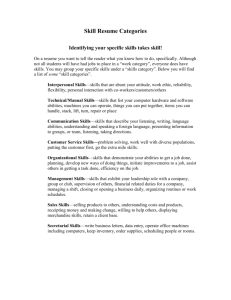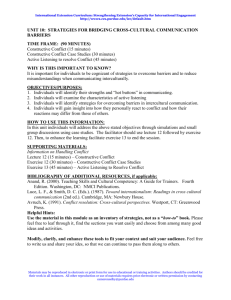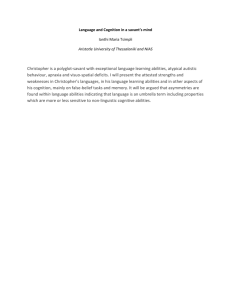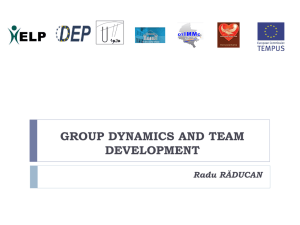Constructive Conflict
advertisement
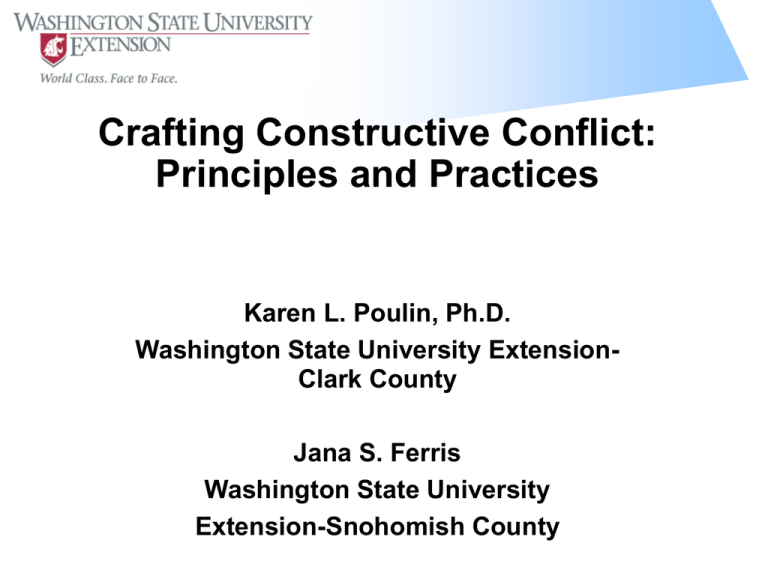
Crafting Constructive Conflict: Principles and Practices Karen L. Poulin, Ph.D. Washington State University ExtensionClark County Jana S. Ferris Washington State University Extension-Snohomish County Workshop Objectives • Introduce a basic model for understanding & dealing strategically with conflict • Explore your individual approach to conflict • Learn & practice core skills • Understand why efforts to deal with conflict often fail Exploring Assumptions About Conflict What do you believe about conflict? Common Assumptions About Conflict & Alternative Views • “Conflict can and should be avoided” Conflict is a normal part of life Conflict can be a source of creativity, energy & learning • “Conflict is a bad thing” Conflict in itself is neither positive or negative Responses to conflict can be either destructive or constructive Exploring Sources About Conflict In your experiences, over what kinds of issues do people have conflict? Common Sources of Conflict • Limited resources Time Money Property • Different Values Beliefs Priorities • Unmet basic needs Physical Psychological Skill Building: Identifying Source • Large Group: brainstorm “Five Typical 4-H Conflicts” • Within your group: determine the possible source of the conflict. “Getting to Yes” Basic Components of a Constructive Process: • Choose a general approach to problemsolving • Take specific steps to implement the approach • Use general principles to guide the process “Getting to Yes”: 3 Common Problem-Solving Approaches • Negotiation: Disputing parties or representatives meet face to face to resolve dispute, unassisted • Mediation: neutral 3rd party (mediator) assists disputants or their representatives • Consensus Decision-Making: Group process, ith or w/out assistance, collaborate to resolve 6 Concrete Steps to Problem-Solving • Set the stage • Gather perspectives • Identify interests • Create options • Evaluate options • Generate agreement Implementing ProblemSolving: 4 Principles • Separate people from the problem: Differentiate between relationship & substantive issues • Focus on interests, not positions: Identify underlying motivations for what is wanted • Invent options for mutual gain: Brainstorm without evaluating • Use objective criteria to evaluate options: Select standards against which to evaluate options The Potent Role of History: The Past in the Present • History of the situation Past critical incidents can intrude on present Emotional reaction can retain original intensity • Personal histories of participants Strategies learned from family-based experiences can later be maladaptive Early traumatic experiences can trigger response mediated by limbic system instead of frontal cortex Foundational Abilities for Constructive Conflict • Perception Abilities • Emotion Abilities • Communication Abilities • Creative & Critical Thinking Abilities Perception Abilities • Empathy: Seeing situation as other does • Self-Evaluation: Recognizing personal fears, style • Suspending Judgment: Putting aside blame long enough to have an exchange of ideas Skill-Building: Developing Empathy through Perspective • Choose a partner • Each person tells partner about conflict situation they’ve experienced First tell from point of view of self Then tell from point of view of other Skill Building: Self-Reflection & Self-Awareness • Complete Adult Conflict Style Inventory From your point of view From a significant other’s viewpoint • Group results? • Debrief: What did you find out? Conflict Styles: Personal Preferences • Collaborating • Forcing • Compromising • Avoiding • Accommodating Another Way to Think About Response Style: The “Getting to Yes” Model • Soft: withdrawing, ignoring, denying, giving in • Hard: threatening, pushing, hitting, yelling • Principled: listening, understanding, respecting, resolving • “Soft” & “Hard” strategies yield lose-lose or win-lose results • “Principled” strategies yield win-win results Emotion Abilities • Recognizing emotions (yours & theirs) • Vocabulary for emotions • Dual attention to internal and external events • Self-control to prevent over-reaction to others’ emotional outbursts Simple De-escalation Techniques to Balance Emotions • “Take a break”: Appropriate exits • Inform other(s) you need break (don’t just storm out) Let them know when you’ll be back to finish “Take a deep breath”: Breathing techniques Physically impossible to sustain stress response & relaxation response at same time Diaphragmatic breathing induces relaxation response Skill Building: Diaphragmatic Breathing • While standing, place one hand on chest, one on abdomen • Breath slowly and deeply, filling lower part of chest cavity with air • Success indicator: As you breath, hand on chest stays still; hand on abdomen moves up and down with inhalation How Do You Do It????? Clarify Needs • Substantive • Procedural • Psychological What are your Desired Outcomes? •Which needs are threatened? •Which needs most need to be negotiated at this time? •Alternatives? •What about the other person? •What do I really want to happen? Safe Place to Negotiate • Space • • Is the space neutral? Mutually convenient/inconvenient? Time Is it scheduled for a realistic time for all parties? Is there enough time to do it right? Ground Rules Agreed upon by all parties Sets the tone Communication Abilities • Expressing emotions & wants in nonaggressive, non-inflammatory ways • “Active” listening skills to convey accurate understanding of other’s experience • Constructive feedback skills to work out tensions on ongoing basis Core Skill: Active Listening • Listener reflects content & emotions • Listener refrains from editorializing • Main skills are non-verbal encouragers, summarizing, paraphrasing What I hear you saying is… If I understand you correctly… Let me see if I’m getting your point… Core Skill: Constructive Feedback • Focus is on observable behaviors rather than “mindread” intentions • Describe what was done well; give specific example • Describe what could be done differently next time to improve; be specific; focus on what to DO rather than on what NOT to do. • Invite reaction/response Skill Building: Active Listening & Constructive Feedback • Form small groups (triads if possible) • Take turns as listener, speaker, observer • Speaker describes a memorable conflict situation s/he experienced or observed: Be detailed; use non-inflammatory language • Listener practices active listening • Observer offers constructive feedback to listener re: active listening, to speaker re: language • Large group debrief Problem Solving With flexibility Creative & Critical Thinking Abilities • Creative Thinking Abilities Considering the situation from several perspectives Brainstorming “outside the box” • Critical Thinking Abilities Recognizing underlying criteria & standards for evaluating possibilities Establishing & applying criteria & standards for evaluating possibilities Skill Building: Approaching Conflict “Creatively” • “Multiple intelligence”: Many ways and skills for knowing • We tend to use rationale-language based processes to deal with conflict • Cutting edge organizations beginning to explore alternatives (e.g., team lego) • Practice for fun: Draw “conflict”. Then, explain your drawing to your partner. Manage Impasse • Go back to desired outcomes • Check your own energy level • Take breaks Why Conflict Resolution Strategies Often Fail • Frequent emphasis on cognitive skills & processes, rush to problem-solving (rather than problem-setting through deep listening) • Emotional/ psychological components often minimized, or avoided Variability & reality of stress/cortisol response underestimated • Potent role of history often misjudged History of situation/problem Personal histories of participants Recap & Final Debriefing What might you take away from today’s experience? And Last But Not Least… Final Questions and/or Comments? THANK YOU!
